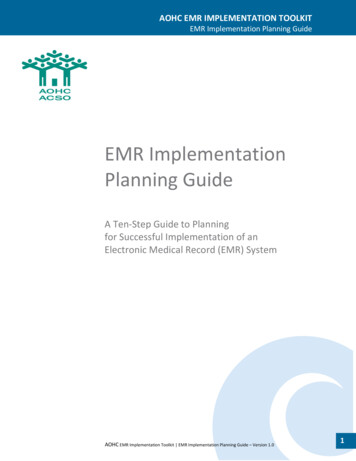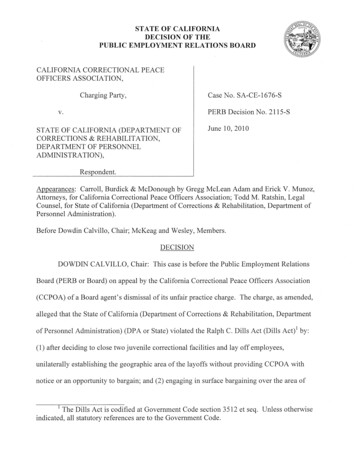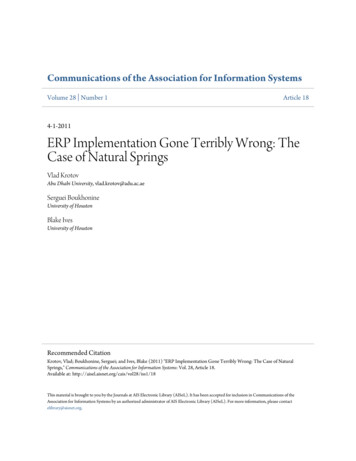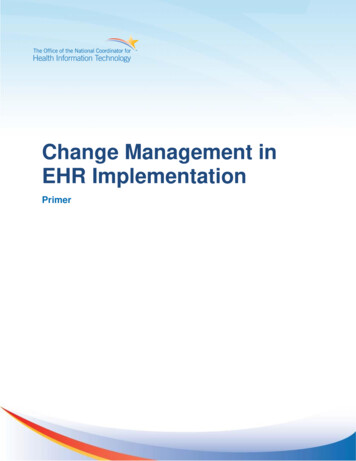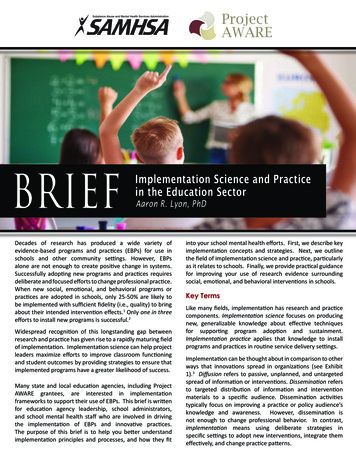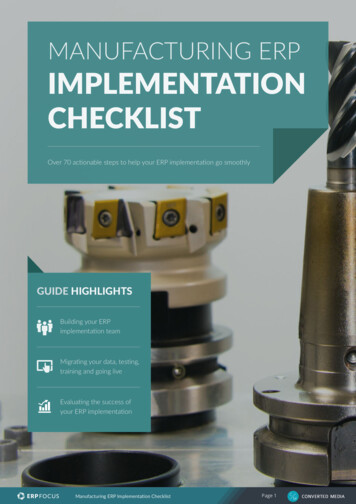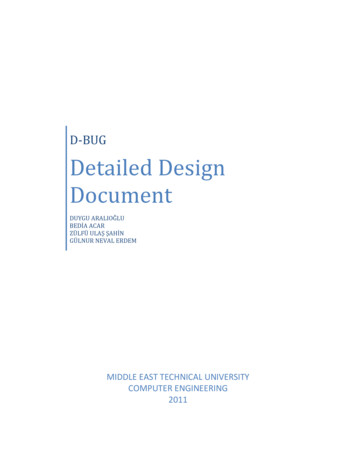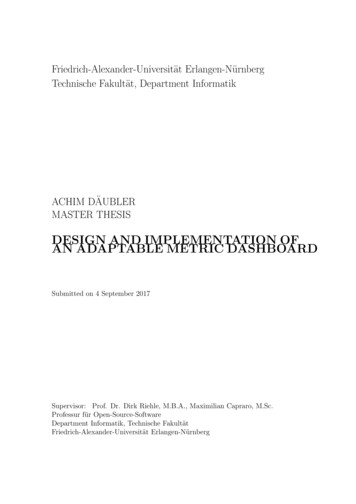
Transcription
Friedrich-Alexander-Universität Erlangen-NürnbergTechnische Fakultät, Department InformatikACHIM DÄUBLERMASTER THESISDESIGN AND IMPLEMENTATION OFAN ADAPTABLE METRIC DASHBOARDSubmitted on 4 September 2017Supervisor: Prof. Dr. Dirk Riehle, M.B.A., Maximilian Capraro, M.Sc.Professur für Open-Source-SoftwareDepartment Informatik, Technische FakultätFriedrich-Alexander-Universität Erlangen-Nürnberg
VersicherungIch versichere, dass ich die Arbeit ohne fremde Hilfe und ohne Benutzung andererals der angegebenen Quellen angefertigt habe und dass die Arbeit in gleicher oderähnlicher Form noch keiner anderen Prüfungsbehörde vorgelegen hat und vondieser als Teil einer Prüfungsleistung angenommen wurde. Alle Ausführungen,die wörtlich oder sinngemäß übernommen wurden, sind als solche gekennzeichnet.Erlangen, 4 September 2017LicenseThis work is licensed under the Creative Commons Attribution 4.0 Internationallicense (CC BY 4.0), see en, 4 September 2017i
AbstractMany software companies use open source development practices inside the company‘s boundaries, which is called inner source. The Collaboration ManagementSuite (CMSuite), developed by the Open Source Research Group at the FriedrichAlexander-University Erlangen-Nuernberg, is a software tool for extraction, analysis, and visualization of data and metrics regarding inner source.Prior to this thesis, CMSuite lacked features to visualize metrics and let stakeholders define their own metrics and visualizations. A programmer had to writecode from scratch, where he defines a metric and then visualizes the result. Furthermore is not fully researched, which metrics will be important in the future,so adding new ones without wasting much time is desirable. This thesis discussesa new Java-based REST-service, which makes it possible to easily add and definenew metrics, using the data integration tool Pentaho Kettle. The result is thenvisualized in an AngularJS 2.0 client component for a metric dashboard. Nowthe user does not have to write any code, but only has to define a metric withthe help of Kettle and can see the results of his metric, immediately. Thus, thisaddition to CMSuite will enable him to save time and test new metrics muchmore efficiently.ii
Contents1 An1.11.21.3Adaptable Metric DashboardPrevious Work . . . . . . . . . . . .Purpose . . . . . . . . . . . . . . . .Requirements . . . . . . . . . . . . .1.3.1 Stakeholders . . . . . . . . . .1.3.2 Functional Requirements . . .1.3.3 Non-Functional Requirements.12233352 Architecture and Design2.1 Basic Design Decisions . . . . . . . . . . . . . . . . . . . . . . . .2.2 Third-Party Tools . . . . . . . . . . . . . . . . . . . . . . . . . . .2.2.1 Pentaho Data Integration (Kettle) . . . . . . . . . . . . . .2.2.1.1 General Info . . . . . . . . . . . . . . . . . . . . .2.2.1.2 Kettle Transformations . . . . . . . . . . . . . . .2.2.1.3 Running Kettle Transformations from Java . . .2.2.1.4 User Defined Steps . . . . . . . . . . . . . . . . .2.2.1.5 Why Kettle is used . . . . . . . . . . . . . . . . .2.2.2 Chart.js . . . . . . . . . . . . . . . . . . . . . . . . . . . .2.3 Domain Model . . . . . . . . . . . . . . . . . . . . . . . . . . . .2.4 Persistence . . . . . . . . . . . . . . . . . . . . . . . . . . . . . . .2.4.1 Database Schema . . . . . . . . . . . . . . . . . . . . . . .2.4.2 Persisting Results . . . . . . . . . . . . . . . . . . . . . . .2.5 Architecture . . . . . . . . . . . . . . . . . . . . . . . . . . . . . .2.6 REST . . . . . . . . . . . . . . . . . . . . . . . . . . . . . . . . .2.7 Server Components . . . . . . . . . . . . . . . . . . . . . . . . . .2.7.1 Transformation Manager . . . . . . . . . . . . . . . . . . .2.7.1.1 Overview . . . . . . . . . . . . . . . . . . . . . .2.7.1.2 Connection between CMSuite and Pentaho Kettle2.7.2 Analysis-Result Provider . . . . . . . . . . . . . . . . . . .2.8 Webclient . . . . . . . . . . . . . . . . . . . . . . . . . . . . . . .2.8.1 Transformation-Manager-Module . . . . . . . . . . . . . .2.8.2 Analysis-Result-Module . . . . . . . . . . . . . . . . . . .66778891010111113131415151718192021232424iii.
2.8.3Dashboard-Module . . . . . . . . . . . . . . . . . . . . . .3 Implementation3.1 REST-Services . . . . .3.2 Services . . . . . . . . .3.3 Pentaho Steps . . . . . .3.4 Transformation Manager3.4.1 REST Service . .3.4.2 Service . . . . . .3.4.3 Transformer . . .3.5 Analysis-Result-Provider3.5.1 REST Service . .3.5.2 Service . . . . . .3.6 Web-client . . . . . . . .24.2626272729293132343435364 Examples4.1 Single-Value-Result Example . . . . . . . . . . . . . . . . . . . . .4.2 Categorized-Value-Result Example . . . . . . . . . . . . . . . . .4.3 Time-Series-Result Example . . . . . . . . . . . . . . . . . . . . .383841435 Evaluation5.1 Functional Requirements . . . . . . . . . . . . . . . . . . . . . . .5.2 Non-Functional Requirements . . . . . . . . . . . . . . . . . . . .4545486 Future Work6.1 Kettle Steps for CMSuite6.2 Reusing Previous Results6.3 More Types of Results .6.4 Simpler Transformations4949505051.References.53iv
1An Adaptable Metric DashboardInner Source (IS) is the use of open source software development practices andthe establishment of an open source-like culture within organizations (Capraro &Riehle, 2017) and an increasing number of companies is making use of it. Riehle,Capraro, Kips and Horn (2016) note that the number of practitioners indicatesthe relevance of inner source research. The reason for the increasing interest is,that inner source practices can have many benefits for a company. Among others,these benefits include increased software reuse as everyone in the company canaccess other teams source code, better code quality due to more people looking atthe code and accelerated development speed. (Stol & Fitzgerald, 2015; Vitharana, King & Chapman, 2010).In order to understand inner source collaboration, the Open Source ResearchGroup at the Friedrich-Alexander-University Erlangen-Nuernberg has developedthe Collaboration Management Suite (CMSuite). With its help, software organizations can continuously extract patch-flow (flow of code contributions). Basedon this data, different metrics, which are a measure for the evaluation of innersource, can be defined. By visualizing the results of these metrics, insights canbe gained, which help developers and development-managers in decision-makingand managing the inner source process.The contributions of this thesis are the following: A domain model for data transformations and metric results The extension of CMSuite to enable users to define metrics at runtime The addition of client components for a dashboard for metric results Support for visualization of three types of results1
1.1Previous WorkCMSuite provides means to measure code-level collaboration. That is solely thecollaboration in the form of patches that are contributed to repositories. A patchis a small package of code changes with bug fixes, new features, or other additions to an ISS component (Capraro & Riehle, 2017). Patch-flow is the flow ofcode contributions across intra-organizational boundaries such as project, organizational unit, or profit/cost center boundaries.The Open Source Research Group Erlangen-Nuernberg developed the so calledpatch-flow crawler as part of CMSuite, which searches various repositories fortheir received commits. It adds information about the organizational unit thecommit originated from and the receiving IS project. The resulting patchesare stored in a database. Because the origin and destination of the patch areknown there is a measure for the collaboration in the company even across intraorganizational boundaries such as projects or organizational units. Using thedatabase, one can define arbitrary metrics to gain information about inner sourceperformance that is valuable for the company. Which metrics are useful is notfully clear yet. Capraro and Riehle (2017) suggest that future research is neededto identify metrics to measure the progress of IS adoption and the quality of ISprograms, projects, and communities.1.2PurposeUntil now, a developer had to programmatically define how raw patch-flow dataand other data is transformed for every new metric. Then he had to write code inorder to visualize his results. As mentioned earlier, it is not known which metricswill be important in the future, or in which specific organizations which ones willbe of interest, as they might have different needs. It is thus desirable to have ameans to try new metrics without loosing too much time.The purpose of this work is to extend CMSuite with client and server components for a metric dashboard. The components allow users to add metrics notforeseen at the initial design time. Addition of new metrics requires no changesto server code and no changes to client code. The results of metric calculationsare visualized in an Angular 2.0 dashboard component. The metrics are easilyuploaded through the web-client in the form of files. The server components areJava-based REST-services, which provide the methods to receive the files andpersist them. Furthermore they provide the methods to retrieve the results ofmetric calculations.2
1.31.3.1RequirementsStakeholdersThe main stakeholders for the newly designed components are: A Developer of CMSuite. He is a programmer, who develops CMSuite. An Administrator of CMSuite. He oversees the operations of CMSuite. A Metric Designer. His job is to design new metrics in order to measurethe performance of a company. An Inner Source Stakeholder. He is somebody who is in any kind involvedin the inner source process.Of course there are more roles related to inner source, like contributor, committer,etc. They are essential to define when the goal is to understand inner source.However, this is not the primary motivation of this thesis. The motivation isto enable IS stakeholders to manage inner source, based on facts and insightsobtained by applying metrics. So these roles were combined to one ”Inner SourceStakeholder” role, which is sufficient for defining the requirements.1.3.2Functional RequirementsWhen defining the functional requirements for the new components, the followinguser stories were found, which describe those requirements:1. As a metric designer, I want to add new metrics at runtime, without havingto change code on the client- or server-side and I do not need to ask adeveloper to change code or the administrator to restart the system.2. As a metric designer/administrator, I want to be able to view a list ofuploaded metrics, with information like name, last successful execution,etc.3. As a metric designer/administrator, I want to be able to kick off a run ofall metrics from a single end-point.4. As a metric designer/administrator, I want to be able to view a list of allruns, which also shows details about the run like date, status, etc.5. As an inner source stakeholder, I want to display visualizations of metricresults for either inner source projects, organizational units or individualsof the company.3
6. As a metric designer, I want to choose from a set of available visualizations,so that I can choose which visualization fits the result data of my metriccalculation best.7. As a metric designer, I want to write metrics that produce one of thefollowing results: A result that consists of only one value, a time series result(time, value pairs) or a categorized value result (category, value pairs).8. As an inner source stakeholder, I want to have support for metrics likethese:(a) Metrics for the whole company ( the root organizational unit)i. Percentage of patch-flow between different types of unitsii. Amount of IS projects hostediii. Amount of active IS projects hosted(b) Metrics for organizational unitsi. Amount of IS projects hostedii. Amount of active IS projects hostediii. External contributions receivediv. External contributions contributed(c) Metrics for IS projectsi. Development activity (amount of patches)ii. Development activity by contributing units (by type of unit)iii. Amount of contributing units (by type of unit)iv. Amount of contributing users(d) Metrics for personsi. Number of IS projects contributed toii. Amount/percentage of contributions to foreign units (by type ofunit)4
1.3.3Non-Functional Requirements1. The time a metric result takes to be displayed in the web-client is a fewseconds at maximum.2. The metric designer does not have to be a programmer. As a result thismeans defining new metrics can be done with a tool using a GUI ratherthan manual coding.3. The tool should not be programmed from scratch but available softwareshould be used, which has to have a permissive licence, to save time andwork for developers.4. The tool offers the possibility to run the metric definitions from Java inorder to be able to integrate it seamlessly into CMSuite.5. The system has to properly handle faulty metric definitions so that nobodyhas to restart or manually fix the state of the system.5
22.1Architecture and DesignBasic Design DecisionsPrior to this thesis, CMSuite was able to extract patch-flow data and store itin a patch-table in the database. Also the information about the organization isstored in different tables. However, CMSuite lacked components to define metrics,that use this information and to execute them. Furthermore, components forvisualizing the results of executed metric calculations were also missing.The fundamental question of the design phase is how the metrics should be definedand executed. Several ideas are discussed in this chapter.The first possible solution is to use design-time defined Java classes for metrics,meaning the metrics are defined in Java, ideally by extending an existing abstractmetric class.Of course this conflicts with many requirements, as the user would have to bea programmer. More importantly though, the module handling metrics wouldhave to be recompiled everytime a metric is added.This could be avoided by using a plugin-mechanism for metrics, which allowsfor adding Java-classes at runtime. This could be done by using Java’s internaldiscovery process, using its ServiceLoader (“Creating Extensible Applications”,2017). Another approach would be to use third party software like a componentframework like OSGI1 . Both let the programmer define a services, which can thenbe loaded at runtime.However, using this approach, the metric designer still would have to be a programmer.Another solution is to use pure SQL to define metrics on the underlying tablesof CMSuite. They could be uploaded or directly entered in the web-client.For this the metric designer would not have to be a Java-programmer, but he hasto know SQL. However, defining metrics using SQL would be too complicated,especially when dealing with organizational units. These have a hierarchical s6
and their connection is defined via references in a table containing the links. Acomplex metric would be nearly impossible to write in SQL.A further idea is to define a DSL (domain specific language), which is tailoredfor CMSuite and which makes it easy to extract the data of the tables andtransform them. A file containing the metric definition, using the DSL couldsimply be uploaded to the server and the server would interpret it and executethe definition.The metric designer would not have to be a programmer, but he would have tolearn the DSL. The big drawback is that this comes with lots of additional workto create and maintain the self-defined DSL. So this solution does not violate anyfunctional requirements, but from a developer’s point of view it brings more workthan any of the other solutions.The next, and chosen, solution is to use an open-source data integration tool formetric definitions. These tools typically offer a GUI, which lets the user definehow data is transformed. Of course, it has to be possible to execute the metricdefinition from Java, so the tool can be integrated into CMSuite.Depending on the data integration tool, this approach is conform with all functional and non-functional requirements. The implementations in the thesis arebased on Pentaho Kettle, as it does not collide with any requirements. It will befurther explained why and how Kettle is used in the next chapters.2.22.2.1Third-Party ToolsPentaho Data Integration (Kettle)As mentioned in non-functional requirement 2, a tool is needed which can beused to implement different metrics. For this it has to extract the raw patch-flowdata from the database, transform the data and store (loads) it to a persistentstorage. In the context of data integration such tools are commonly known asETL (extract, transform, load) tools (Casters, Bouman & Van Dongen, 2010).There are several popular open source tools, such as Pentaho Data Integration2(also known as Kettle) and Talend Open Studio3 . CMSuite now uses PentahoData Integration, which is introduced in the next d-open-studio7
2.2.1.1General InfoPentaho is a business intelligence (BI) software company4 . It offers open sourceproducts which, among many other features, provide the desired ETL capabilities. Pentaho follows a dual-license strategy, which is a known open core businessmodel (Lampitt, 2008). This means Pentaho offers enterprise and communityeditions for most of their products. The enterprise edition contains extra features not found in the community edition. Development to the core engines inthe platform - Analyzer, Kettle, Mondrian are all included in the communityedition (CE). These are frequently enhanced by the company itself. But thecommunity also contributes to the overall project - mostly QA, but also bug-fixes(Moody, 2017). Features built on top of the core are only available in the enterprise edition (EE). The enterprise edition is available under a commercial license.The community edition is a free open source product licensed under permissivelicenses. The projects are owned by Pentaho, which managed to create an activecommunity around their projects, while generating revenue from them. This socalled single-vendor commercial open source business model brings many benefits for the company and the community, as the company offers a professionallydeveloped product of compelling value to the community that this community isfree to use under an open source license (Riehle, 2012). On the other hand, thecompany is solely in control of their products and can relicense or change themas they consider it appropriate.For this project only the community edition of Kettle is used. It is licensed underthe Apache License, Version 2.0 (“Pentaho Licenses”, 2017).2.2.1.2Kettle TransformationsPentaho Data Integration (PDI), also known as Pentaho Kettle, offers the mentioned extraction, transformation, and loading (ETL) capabilities. It consistsof a data integration (ETL) engine, and GUI applications that allow the user todefine so called transformations. In Kettles terminology a transformation handlesthe manipulation of rows or data. It consists of one or more steps that performcore ETL work such as reading data from files, filtering out rows, data cleansing,or loading data into a database (Casters et al., 2010).Figure 2.1: example transformation4https://www.pentaho.com8
Spoon is a graphical design environment that allows users to design transformations by choosing from a wide range of predefined steps. The user can simplydrag and drop the steps onto his workspace. He defines the properties of eachstep and connects them with so called hops. The finished transformation contains a set of connected steps. The first step typically loads data from a datasource, such as a database or from the file-system. The subsequent steps definehow data is altered until it flows into the last step, which usually stores the datato a destination, such as a database or the file-system. By connecting the stepsone can define arbitrary transformations of the data.Figure 2.1 shows a very simple example of a transformation that is opened inSpoon. It reads rows from a database table, filters them by a criteria defined inthe ”Filter Rows”-step and writes the filtered rows into the destination table.The data that flows from step to step over a hop is a collection of so called rows,containing one or more fields. Rows can be imagined the same as rows of a database. Its fields can have different data formats, like numbers, dates or strings.Steps are executed in parallel. When a transformation is executed, one or morecopies of all its steps are started in separate threads. They keep reading rows ofdata from their incoming hops and pushing out rows to their outgoing hops untilthere are no more rows left. As the data is processed in this streaming fashion,the memory consumption it kept minimal. This is an important requirement forbusiness intelligence applications, that usually deal with huge amounts of data(Casters et al., 2010).From Spoon, transformations can be saved to the file-system in the form of xmlstructured project files, with the file-ending ”ktr”. They can be opened by Spoonand can be edited further and can also be executed from there. More importantlyfor this project, they can also be interpreted and run by Kettle’s data integrationengine, which is explained in the next chapter.2.2.1.3Running Kettle Transformations from JavaAs mentioned in non-functional requirement 4, for our purposes, there has to bethe possibility to run the transformation from Java. Fortunately Kettle offers thepossibility to interpret and run the ktr files, using its Java API. The API is splitup into different jars.For this project, the dependency to kettle-core and kettle-engine are added.Kettle-core contains the core classes for Kettle and kettle-engine contains theneeded runtime classes. As the transformations use a database connection, theJDBC driver dependency, for the database used (PostgreSQL), are added as well.In Java one can do everything that can be done in Spoon, eg. define a new transformation, or alter an existing one. This is useful, as in chapter 3 it will beimportant to to overwrite an existing database connection of a transformation,so it can be tested locally with another database connection.9
Also you can run the transformation with parameters, which is important as itneeds some context about our environment. (the transformation-id and the id ofthe transformation-run).2.2.1.4User Defined StepsPentaho Kettle offers the possibility to write steps yourself. This is interestingbecause it allows for defining steps tailored for CMSuite, which can be used tomake the metric designer’s work easier.In order to write own steps, one has to implement four interfaces, so that itintegrates into Kettle (“Create Step Plugins”, 2017). In short, the first onemainly defines the steps settings. The second one defines the setting dialog,using SWT5 . The third interface defines how the input rows are transformed tooutput rows. The fourth one defines the field variables used during processing.2.2.1.5Why Kettle is usedTalend Open Studio for Data Integration offers the same functionality as PentahoKettle. It is licensed under the Apache License v2. It also provides a GUI inwhich one can simply put together steps, like in Spoon. It also is possible todefine steps yourself and use them. Furthermore Talend also allows to run jobs(transformations are called jobs in Talend) from Java. The problem with Talendis that it operates as a code generator (Barton, 2013), which produces Javacode, whereas Kettle saves its transformations as xml-styled ktr files, which areinterpreted by its engine.Via Open Studio’s GUI the user can export a job as a standalone jar file. Itcontains all dependencies needed for running the job. In order to integrate thejob into an existing Java application, it would be necessary to execute the jar filefrom Java, eg. by adding the jar to the build path and call the jars main classin the applications code. So the whole application would have to be recompiledeverytime a jar is added. Either way the problem is, that the application isisolated and thus it is not possible to alter properties of the job from the Javacode. As mentioned before, it makes sense to force the transformation or jobto use the database connection defined in CMSuite, which can only be done ifthis property of the transformation or job can be overwritten in the code. Alsoif metric designers would use different versions of Talend, the jars would usedifferent implementations. With Pentaho there is always only the version of theengine used, which is defined in the project properties. This engine then can5https://www.eclipse.org/swt10
interpret the xml-styled ktr files, regardless with which version of Kettle theywere created.All in all Talend is more suited to be used by itself and run its jobs from the GUIor export a job as jar, which can be run from the command line. When it comesto integrating Talend job into an existing application, which is what we want, itdoes not seem suitable for that.2.2.2Chart.jsFor visualizing results in the web-client, a JavaScript library is needed that isopen source and provides chart types suitable for displaying the different typesof results.Chart.js6 is a simple but flexible JavaScript library that provides all necessaryfeatures. It supports all basic chart types, such as line-, bar- and pie-charts,and more. It also is highly configurable, so things like color, labels, animations,legends can be set in the JavaScript code. Furthermore it has no dependenciesto other libraries.All in all it is easy to use and not overloaded with unnecessary features. Chart.jsis open source and is available under the MIT license, so it can be used in thisproject.2.3Domain ModelThe domain model in figure 2.2 shows all classes that were derived from therequirements descriptions and user-stories. The OrgElement, Person and InnerSourceProject classes however existed before this thesis and represent an organizational unit, a person, that is part of an organization, and an inner sourceproject. The newly introduced domain classes are the following: EconomicAgent: An interface for all classes that represent an entity forwhich a transformation can run. These so called agents are OrgElements(organizational units), InnerSourceProjects and Persons. Transformation: A metric is a measure for the evaluation of the qualityof inner source development practices. A transformation, as it is calledin Pentaho Kettle, is a description of how data is read, transformed andstored, as mentioned in chapter 2.2.1. It is saved as Kettle TransformationFile (.ktr). A metric is calculated by executing a transformation, thatdefines the steps to create the results for this metric. The Transformation6http://www.chartjs.org11
Figure 2.2: domain model12
class contains the meta-data about the transformation: The name underwhich it will appear in the client, the type of result it produces and thetype of agent it applies to. Also a reference to the latest successful run, inwhich it was executed, is stored. TransformationRun: Contains all information about an execution of transformations. It contains the date, when the run was started, as well asinformation about its current status. That is if the transformations arecurrently running, if the run finished successfully or if the run failed. AnalysisResult: Represents the base class for a result of a transformation.It contains references to the EconomicAgent it belongs to and to the Transformation that produced the result. SingleValueResult: Contains a result with one value. It is used to representresults for metrics, that produce only one value for each EconomicAgent.For example: Metric for persons: ”Number of patches ever contributed”. CategorizedValueResult: Contains a result with multiple key-value pairs.This is used to represent results for metrics, that produce multiple keyvalue pairs for each EconomicAgent. For example: Metric for inner sourceprojects: ”Number of patches ever contributed to the project per person”. TimeSeriesResult: Contains a result with multiple key-value pairs, withthe key being a date. This is used to represent results for metrics, thatproduce multiple date-value pairs for each EconomicAgent. For example:Metric for organizational units: ”Number of patches originating from theunit per year”.2.4PersistenceBefore visualizing, the raw patch-flow data has to be transformed according to auser defined metric. It was decided that the results of such a transformation haveto be persisted, as calculating it every time a visualization is requested would leadto very long response times, which conflicts with non functional requirement 1.Of course, Transformation- and TransformationRun-objects also have to be persisted. The different types of AnalysisResult are not directly persisted, but derived from the persisted ResultRows.2.4.1Database SchemaThe transformation-, transformationrun- and resultrow-table were added to theexisting database schema:13
Figure 2.3: Database SchemaThe transformation- and transformationrun-table directly correspond to theirdomain objects. The types of result do not appear here, as they are derived fromthe entries in the resultrow table, which is explained in the next chapter.2.4.2Persisting ResultsWhen designing the result types, the question arose, how the results generatedby a transformation sh
new metrics, using the data integration tool Pentaho Kettle. The result is then visualized in an AngularJS 2.0 client component for a metric dashboard. Now the user does not have to write any code, but only has to de ne a metric with the help of Kettle and can see the results of his metric, immediately. Thus, this
